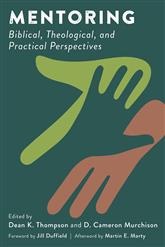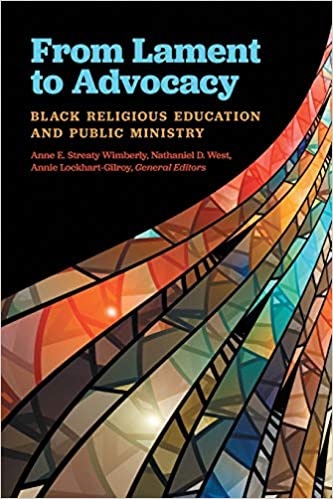
Book Reviews - 29 results
Select an item by clicking its checkbox
Mentoring: Biblical, Theological, and Practical Perspectives
Date Reviewed: December 13, 2018
In Mentoring: Biblical, Theological, and Practical Perspectives, Thompson and Murchison provide a thoughtful collection of essays on Christian mentorship. As a whole, this collection contributes to the growing body of scholarly work on mentoring by offering “windows on mentoring that are biblically grounded, theologically informed, communally diverse, and generationally attentive” (3). The book is divided into four parts, with each of the fourteen chapters highlighting the twenty-one contributors’ unique analyses and insights on mentoring and being mentored.
Part 1 surveys biblical perspectives on mentoring. As such, it begins with Brueggemann’s consideration of mentoring practices present throughout the Old Testament and concludes with a posthumous essay by Bartlett on passages in the New Testament that help to shed light on contemporary understandings of the term “mentor.”
Part 2 examines the nature and task of mentoring from a variety of theological perspectives and methods. Drawing on the fields of pastoral ministry (Currie), homiletics (Long), ethics (Miles), and feminism (Rigby), the authors provide a range of mentoring models and resources that underscore the importance of positive mentoring relationships and practices in the formation of strong Christian leaders. On this Rebekah Miles writes, “Christian mentoring should include discussion of the ways that our professional goals contribute to the larger goals of Christian life” (83).
Part 3, “Diverse National and International Communities of Mentoring,” explores Christian mentoring practices as shaped by particular contexts, including race, gender, and ethnicity. Those who wish to think critically about dominant systems of oppression, such as racism, xenophobia, and sexism, and to foster concrete practices for inclusive mentoring within biblical-theological frameworks will find a wealth of resources in the essays by Pollard, Cannon, De La Rosa, and Kwok. Of particular note is Canon’s proposal that womanist mentoring is a vocational call, “to do the work your soul must have” (123). This section also includes an historical essay by Johnson on mentoring in the Roman Catholic tradition.
Finally, Part 4 contains three coauthored chapters that discuss mentoring as a mutually supportive practice that occurs across generations. Ottati and Hinson-Hasty’s essay, “Mentoring toward a Humane Disposition, Attitude, and Imagination,” describes mentoring relationships between the teachers and student, while Nishioka and Lowry and Wardlaw and Murray’s essays consider youth and cross-generational mentoring, respectively
The book closes with an afterword by Marty that skillfully and poetically weaves together the insights and value of this collection of essays. He writes, “It is impossible to speak properly about mentoring in entirely impersonal and theoretical terms. Mentoring is and is about a profound personal dimension of scholarly and pastoral work” (223).
Those working in theological schools or departments and in Christian ministry will find this collection of essays to be a valuable resource on the virtue and art of mentoring. The strength of this volume lies not only in its biblical and theological reflections on mentoring, but also in the range of everyday lived experiences and perspectives from which the authors write.
Date Reviewed: June 17, 2021

How Youth Ministry Can Change Theological Education - If We Let It
Date Reviewed: March 29, 2017
Acutely aware of the North American religious landscape, the editors introduce the volume by noting two ironies – a vast majority of young people subscribe to a superficial understanding of self, God, and the world, and those who are more complexly informed are often mistakenly considered by youth ministries to be “already won” (8). With this awareness, the editors bring together a diverse set of essays that intentionally make an effort to overcome this irony. By making critical references to High School Theology Programs, the different authors weigh in on the matter by treating high school students as full persons who desire and invite serious mentorship, challenge conventionally held notions, and are ready to hit the spiritual formation ball out of the park.
Several authors highlight how young people are often liturgically formed by dominant social conventions that impact their behavior and their ability to articulate the meaning of self and world. If young people are thus culturally tutored, how can those in youth ministry enable a different way of theologically framing lived experiences? How can they creatively disrupt unhelpful naming systems, for example, that young people are enculturated into in such a way that naming the issue could become a means to rethink and rename ways of being in the world? What would this take and what would it cost?
Each author presents arguments and perspectival interventions that are based on hard evidence and long-term work with high school students. Work with youth, in the end, affects youth and those who work with them. The book argues that such giving and receiving offers grounds for holy friendship and mutual companionship that can and will positively change self and world. Faculty members in theological schools are encouraged to actively seek out for themselves and others opportunities to teach age groups that they may not otherwise readily engage. No age is “too young.” While the difficulty of the task is not underestimated, the rewards, the authors argue, are many. Church workers are called to focus not so much on saving churches but rather on “saving lives” (275). Both may eventually be saved in the process.
The subtitle “If We Let It” captures the philosophical framework of this book. Readers interested in learning how youth ministry can change theological education – if we let it – will learn a great deal from this work that serves as a well-researched handbook, an indictment of theological malnourishment, and a mirror that poses hard and important questions to those interested in more than a cosmetic makeover of theological education today.

Interreligious Learning and Teaching: A Christian Rationale for a Transformative Praxis
Date Reviewed: February 4, 2016
Published in the Fortress Press series, “Seminarium: The Elements of Great Teaching,” this affordable, concise volume is targeted for Protestant seminary professors in particular but will also be of value to those working in Christian higher education and ministry, more generally.
The teacher-friendly format features three chapters of text by K. Johnston Largen, punctuated by sequentially numbered, stand-alone text boxes of “Praxis Points” by C. Lohr Sapp, and responses to each chapter and an epilogue by M. E. Hess. The text offers many useful resource references including texts, websites, and video clips. Quick Response codes intersperse the text and the relevant URLs are also provided in footnotes.
The first chapter presents four specific examples of interreligious experience relating to Hinduism, Islam, Buddhism, and Judaism, in order to demonstrate the urgent and practical importance of interreligious education and dialogue. The second chapter offers a theological rationale for such learning drawing upon insights of comparative theology. The third chapter suggests expected outcomes and pitfalls, strategies for including interreligious learning within a theological curriculum, and considerations for assessing transformative praxis for students, faculty, and institutions.
The format highlights the richness of collaborative work that coheres well throughout the volume yet offers distinct contributions by each authorial voice, modeling the value of dialogue in its overall presentation. Theological references are primarily Lutheran and Roman Catholic but also model dialogue within Christian diversity. A further dialogue which informs all aspects of this text involves pedagogical scholarship, particularly literature associated with adult learners. Each author demonstrates pedagogical depth and writes in a personal, accessible, and occasionally humorous tone.
Since the authors emphasize the importance of meeting students where they are and structuring learning opportunities with this in mind, a great deal of attention is paid to resistance and fears some Christian students continue to have toward learning about other religious ways and practices.
Readers who are not actively involved in communities or educational settings that reflect this tension and ambivalence may be impatient with the introductory nature of the volume. The authors write to convince and inform those who are beginning or seeking to encourage others to begin this type of transformative praxis.

Play and the Human Condition
Date Reviewed: November 30, -0001
Thomas Henricks’ Play and the Human Condition provides a valuable guide to the academic study of human play. Henricks has been teaching at Elon University since 1977 as a sociologist. He has been studying human play since his PhD dissertation, which explored the relationship between sports and social stratification, and he has over thirty years of academic publications in play studies. In this volume, Henricks attempts to advance his thesis that “play is fundamentally a sense-making activity and that the broader goal of this process is to construct the subjectively inhabited sphere of operations and understandings called the self” (209).
Henricks organizes this book into an introduction and nine chapters. He begins the introduction with three questions that guide his work: “How do we discover who we are? How do we determine the character of the world in which we live? And how do we decide what we can do in a world so configured?” (1). The introduction provides a rationale for studying play as well as an overview of the book.
The first three chapters explore general models of play. In Chapter I, Henricks explores the difficulties around establishing a definition for play as he reviews several modern definitions. He presents six ways of understanding play: as action, as disposition, as experience, as context, as interaction, and as activity while he connects each model to their major theorists. The next chapter presents how play is different from other patterns of human behaviors including ritual, work, and communitas. The final chapter in this section develops a theory of play that centers upon self-realization. Henricks notes that “play best teaches people how to conceive self-directed lines of action and to mobilize varieties of resources to realize these ambitions” (89).
In the middle of the book, Henricks devotes five chapters to various aspects of play including psychology, the human body, physical environment, social life, and culture. After focusing on the mind in his chapter on the psychology of play, Henricks turns to the human body and play in Chapter Five. While examining animal play, he concludes “play integrates symbolic and physically based meaning systems. . . play is a form of consultation between matters manifest and latent, known and unknown. In consequences, players extend and secure their understanding of themselves” (137). Next, he engages the physical environment and social aspects of play, because as he explains, “play is complicated by the presence of more than one player” (161). Chapter Eight builds upon the foundation of the earlier chapters to explore culture and play. This is an important chapter that engages the work of Geertz, Deerida, and Gadamer to list a few.
Henricks’ final chapter weaves the various themes of the earlier chapters together to support his thesis. He examines the relationship between play and freedom. He concludes that “if play has a legacy, it is its continuing challenge to people of every age to express themselves openly and considerately in the widest human contexts” (227).
Play and the Human Condition is a well-developed and scholarly text. Henricks engages a wide range of disciplines and carefully builds his arguments. The book offers a detailed road map to professional play literature that will be very useful to any scholar researching in this field. Except for a few terms, like communitas, this volume is accessible for the non-specialist. Theologians and graduate students should have no problem understanding and engaging this text in fruitful dialogue.
This volume would be a good addition to major theological libraries. It is especially important for scholars and programs that explore ritual studies and hermeneutics. Chapter Four, on play as therapy, gives a foundation for this important approach to clergy who want to explore this avenue of pastoral care and counseling.


